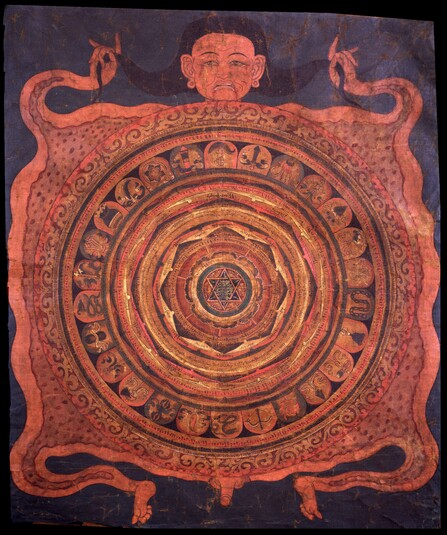
Item: Mandala of Chart - Yantra Diagram
| Origin Location | Tibet |
|---|---|
| Date Range | 1700 - 1799 |
| Lineages | Sakya and Buddhist |
| Material | Ground Mineral Pigment on Cotton |
| Collection | Rubin Museum of Art |
| Catalogue # | acc.# P2000.15.2 |
Classification: Object/Concept
Mahakala Yantra atop a flayed human skin.
Yantras are devices, essentially magical devices, used to bring about a desired effect, or result. They are drawn, painted or inscribed on paper, cloth, wood or metal. Called by different names they are found almost everywhere in the world amongst every culture. The Indian sub-continent is particularly rich in the culture of magic. There are a vast number of texts in Indian and Tibetan literature describing and illustrating the various types of yantras and their ritual practices. Love charms and the acquisition of wealth are two of the most popular uses for yantras. Protection for oneself and family along with cursing and wishing malevolence on others are equally popular. The painting here is a large format yantra intended for protection and specifically used in rituals for protection of the person, family or community. The image of the flayed human skin indicates that the type of protection being employed is extremely fierce and possibly dangerous. Objects and rituals such as this are used and performed with caution. A reading of the many Sanskrit inscriptions reveals that the deity associated with this yantra is the horrific Buddhist protector Mahakala. In the Hindu and Buddhist traditions most deities and gods have various yantras associated with the mundane worldly activities like the acquisition or wealth, power, long-life and subjugation. There are also many types of yantras that are not related to deities.
Atop the flayed skin is the circular yantra. Not all yantras are round. They can be in any shape imaginable and are generally simple in design. For this complex yantra there are four outer rings. The first is a circle of fire followed by three inner circles of mantras and prayers written in Tibetan script but in both Sanskrit and Tibetan language. Twenty-six objects, primarily weapons, are each depicted on lotus-like petals. Inside of that is another circle of inscriptions based on the principal recitation formula of Mahakala known as the 'shasana' mantra followed by the 'namah samanta' mantra of the Vajra Panjara Tantra . Inside of that are a series of five weapon wheels. These wheels have protruding blades in the shape of sharks' teeth. Each ring is inscribed with mantras as are the spaces between the blades and the wheels.
The innermost structure of the yantra is surrounded by an outer lotus with eight petals followed by two rings of inscriptions. The heart of the yantra is made of two red interlocked triangles with inscriptions in gold lettering on a blue background. For purposes of protection an individuals name or the names of an entire family can be written at the center of the yantra. For the opposite purpose of causing harm or cursing then the victims name is placed in the center or alternately between the blades of the weapon wheels. For bringing two people together in a love charm then both names are written at the center. Large painted yantras are used for elaborate rituals. Small yantras can be written on paper, or created as prints from wood block carvings, and are generally worn on the body. Yantras are also commonly placed above doorways and entrances to private dwellings throughout the Himalayan regions, Tibet and Mongolia.
Jeff Watt 11-2008
Exhibition: Mandala, The Perfect Circle (RMA)
Thematic Sets
Subject: Linga Effigy
Mandala: Shape, Form & Composition
Subject: Shapes (Weapon Wheel)
Collection of Rubin Museum of Art: Painting Gallery 9
Painting Type: Charts Main Page
Mandalas: Nyingma Tradition
Charts: Yantra Diagrams Main Page
Collection of Rubin Museum (Interesting Mandalas)
Collection of Rubin Museum of Art: Mandala
